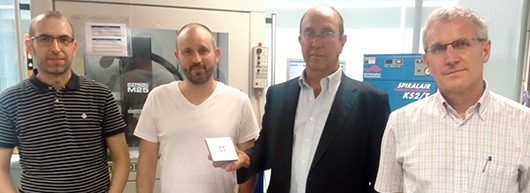Researchers of the Institute of Telecommunications and Multimedia Applications (iTEAM) of the Universitat Poliècnica de València (UPV), have developed a new device that is able to increase the efficiency of satellites, reducing, at the same time, their cost.
The radiating cell is a prototype that integrates the four typical beams of muti-spot beam satellites. Nowadays, these beams are provided by means of four different antennas, with their corresponding reflector apertures, whereas the device designed by the iTEAM gathers all the beams in a single structure.
“We have transformed a filter into an antenna”
Patented by the UPV, the device is able to provide, like multi-beam antennas, wideband two-way communications, and will allow to solve the problems of high weight in satellites by reducing considerably their size.
In addition, the new cell facilitates the location of the classical reflector antennas and their feeders, which often are an added difficulty when implementing the satellite and increase their cost.
As the researcher Marco Guglielmi indicates, “the novelty of this structure is that it is normally formed by an input and output ports with coaxial cables, and we have made the input with a coaxial cable, but the output is the free space. We have transformed a filter into an antenna”.
Less is more
With this innovation, in a device with a palm of a hand size, it would be possible to concentrate into a single structure the four beams that were formerly radiated by bulky conventional antennas, without altering the satellites coverage. “The coverage”, affirms Mariano Baquero, researcher of iTEAM, “would be exactly the same as those of current systems, but with a quarter of the antennas”.
Wide range of possibilities
Apart from satellites for telecommunications, the features of the new device permit its application to a wide range of antennas, as well as to different technologies, integrated with other devices. For instance, it could be applied to space communications, and, hence, to any application in which it is required an antenna capable of generating, with a single aperture, several separate beams.
International collaboration
The creation and development of the device has been carried out by means of the participation of five Spanish and Italian inventors: Piero Angeletti y Giovanni Toso, of the European Space Agency in the Netherlands; Marco Guglielmi, invited researched at the UPV, and Vicente Boria and Mariano Baquero, members of iTEAM.

